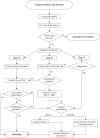Pelvic ring fractures in the elderly
- PMID: 31312519
- PMCID: PMC6598730
- DOI: 10.1302/2058-5241.4.180062
Pelvic ring fractures in the elderly
Abstract
Pelvic ring fractures are rare injuries in the elderly though the incidence is increasing due to the increasing age of the population.Main goal of treatment is the quickest possible re-mobilization to prevent side-effects of immobilization such as osteopenia, pulmonary infections or thromboembolic events.Isolated anterior pelvic ring fractures are stable injuries and therefore they usually can be treated conservatively, while pelvic ring injuries with involvement of the posterior ring are considered unstable and should undergo surgical stabilization if the patient's condition allows for it.Conservative treatment includes adequate analgesia, guided mobilization with partial weight bearing if possible and osteoanabolic medication.The appropriate surgical procedure should be discussed in an interdisciplinary round considering patient's pre-injury condition, anaesthetic and surgical risks. Cite this article: EFORT Open Rev 2019;4 DOI: 10.1302/2058-5241.4.180062.
Keywords: geriatrics; insufficiency fractures; osteoporosis; pelvic ring fractures.
Conflict of interest statement
ICMJE Conflict of interest statement: US reports consultancy fees from Aesculap, KLS, Merete, OPED, outside the submitted work. All other authors have nothing to declare.
Figures




References
-
- Putschar WG. The structure of the human symphysis pubis with special consideration of parturition and its sequelae. Am J Phys Anthropol 1976;45:589–594. - PubMed
-
- Dalstra M, Huiskes R. Load transfer across the pelvic bone. J Biomech 1995;28:715–724. - PubMed
-
- Dalstra M, Huiskes R, Odgaard A, van Erning L. Mechanical and textural properties of pelvic trabecular bone. J Biomech 1993;26:523–535. - PubMed
-
- Goel VK, Valliappan S, Svensson NL. Stresses in the normal pelvis. Comput Biol Med 1978;8:91–104. - PubMed
-
- Tscherne H, Pohlemann T. Tscherne Unfallchirurgie. Berlin, Heidelberg, New York: Springer, 2014.
Publication types
LinkOut - more resources
Full Text Sources
Medical

